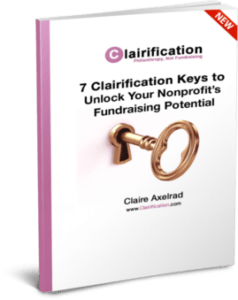 Your organization won’t survive and thrive with only great fundraising technicians. You—and the entire social benefit sector—need organizational-development-grounded philanthropic facilitators. In fact, you need a team – maybe an entire village – filled with them!
Your organization won’t survive and thrive with only great fundraising technicians. You—and the entire social benefit sector—need organizational-development-grounded philanthropic facilitators. In fact, you need a team – maybe an entire village – filled with them!
This is what it looks like in a culture of philanthropy. And it involves more feelings than tangibles. What does it feel like where you work?
Your organization’s culture can make or break your fundraising – and just about everything else. If you don’t foster a culture in which people want to work, great professionals won’t apply for, or stick with, jobs. You have to be intentional in creating a culture that attracts, retains and grows professionals. The kind who will inevitably build sustaining relationships with supporters.
Here are some things you can do to build a true philanthropic culture.
Say what the culture is, get buy-in; demonstrate it.
To foster an authentic values-based organizational culture, you must first identify and write down the main beliefs that make up the culture. This can be simple – as little as a sentence or single paragraph – but this written manifestation of the culture you want to foster is critical to helping people understand the culture.
Here are some questions to ask yourself or, better yet, to do as a group exercise with a team of staff and/or board.
-
Do you have clarity on your values?
-
Do you have a values statement?
-
How is your values statement expressed?
-
Do you have internal buy-in to those values?
-
Do you have external buy-in that matches your internal values?
-
How do you live your values?
Culture is not a script or a tag line; it’s much more. So the goal is not to merely say what the culture is, but to demonstrate it. Writing it down, posting it on the wall, publishing it in your employee handbook, or hearing managers (or yourself) repeat the same language over and over, does not a culture make. Saying what your culture is does not remove your responsibility to foster it. Don’t just say what your culture is. Culture must be practiced.
Make the culture your own.
Read the written language identifying your organization’s culture; reflect on it. Allow yourself to interpret the culture in your own way to lead with authenticity. Here are some questions to ask yourself.
-
What do the values mean to you?
-
How do you demonstrate the values?
-
What other ways might you demonstrate the values?
How you demonstrate one or more of your organization’s values may be different than how this manifests in others. That’s okay. The goal of this exercise is to own these values personally. Find a way to give them significance for yourself and to use them in how you approach your work. This should help you infuse otherwise meaningless tasks into more resonant and joyful activities.
Ask others what the culture means to them.
Show you are interested in how other people view the organization’s culture. This is especially important if you lead a team, as it can be a great jumping off place for discussions that foster a feeling of community and esprit de corps. See where you agree and/or disagree. Explore the differences and nuances. Here are some questions to ask others.
-
What aspects resonate with them?
-
What aspects are they unsure about?
-
What does the organizational culture mean to them?
-
How do they make the culture their own?
-
What ideas do they have for how the organization can live the culture?
For culture to permeate, it must be meaningfully sensed. As in heard, witnessed, felt and shared. The goal is to empower your peers and direct reports to lead authentically, rather than simply parroting corporate mumbo-jumbo.
Make the culture the air you breathe in.
Culture cannot be something dictated and practiced robotically. Every person embodies organizational culture differently. And that’s a wonderful thing as long as it aligns with essential underlying values. You want to make room for people to embrace how they understand the culture, and what this means to them in their daily interactions – with other staff, volunteers, clients and donors. This is the only way culture will be truly owned.
A living, breathing culture is one where you’ll find a growing, thriving organization. The air in such an organization is healthy and nourishing. It makes people feel light, free and open to possibilities. You not only breathe this rarified air in, you also exude it.
Make the culture the air you exhale.
The one thing common among a group of people working together within a philanthropic (“love of humanity”) culture is how they treat each other. People aren’t out for themselves only, because they understand they need each other. The whole is greater than the sum of its parts. It takes a village.
Every single day people working within a culture of philanthropy approach their work from an attitude of gratitude, not greed. A place of abundance, not scarcity. And they’re constantly asking, of everyone they encounter – bosses, direct reports, peers, board, other volunteers, users of services, vendors, community members and donors:
-
“How may I help you today?”
-
“How might I facilitate your journey?”
-
“How might I deliver a little happiness your way?”
Additionally, the air in a philanthropic culture is filled with fundraising molecules. Among the 16 diverse charities highlighted in the groundbreaking study Bright Spots from the Evelyn and Walter Haas, Jr. Fund, all of them shared the following characteristics:
-
Fundraising is core to their identity. It is viewed as a revenue, not a cost, center.
-
Fundraising is distributed broadly across staff, board and volunteers. It is seen as a form of leadership development, organizing and power building, not merely financing.
-
Fundraising succeeds because of authentic relationships with donors. These organizations include in their mission helping donors identify and reach their personal goals, much as they do with their direct service clients. Fundraising is never viewed as merely transactional, but as relational.
-
Fundraising is characterized by discipline, persistence and intentionality. Emphasis is placed on communicating the truth, rather than spin. Development and communications functions are inextricably linked. Strong, trusted non-siloed relationships exist among staff. And continuous learning is built in.
Within Bright Spots, the third from the Haas, Jr. Fund in a series exploring development of a culture of philanthropy, among the findings that most struck me were these comments from people working in and/or supporting these enlightened cultures:
“I knew from the beginning, even in the hiring, that everyone was expected to fundraise. I have to, and everyone else does too. So I was ready for it and able to adapt quickly.”
— Tanya Gonzalez, Coalition for Human Immigrant Rights of Los Angeles (CHIRLA)
“Each month at a staff meeting we talk about the fundraising plan and how it’s going, about the importance of fundraising, and about the role that all staff have regardless of their specific position. We even take time to do donor follow-up calls together there in the meeting.”
— Lulu Reboyoso, Mujeres Unidas y Activas (MUA)
“Mission-driven fundraising is tough and it isn’t necessarily driven by the goal to raise the most money. It’s driven by the goal to change the world. We’re reaching many supporters of our issues in our organizations, and we need to make them financial supporters, as well.”
—Beth Rayfield, CHIRLA
“Fundraising and organizing are about relationships, so the longer you have to build relationships the better you’re going to be at it. That’s the thing about longevity.”
— Bob Fulkerson, Progressive Leadership Alliance of Nevada (PLAN)
“Once we realized that we were actually doing a favor to the donor by providing them a way to give to a cause they cared about, that’s when our minds started to shift.”
— Juana Flores, MUA
“You see a lot of organizations that advertise and ask but I don’t see them fighting the fight. That’s what makes me support CHIRLA. They are supporting me, too. That is something that I can’t describe in words.”
—Donor, CHIRLA
Closing thoughts.
A philanthropic culture does not exist just because you say it does. Your organizational values are not practiced simply because you write them down. Culture must be lived and practiced daily. For this to happen, it’s essential you – and all your stakeholders – personally, and as a group, own this culture.
Within a true culture of philanthropy everyone is involved in fundraising. Or, as I prefer to call it, philanthropy facilitation. And it’s nothing to fear when placed in its proper framework. Fundraising is servant to philanthropy, not an end in itself. Fundraising is “love of humanity” work in its purest sense. Because within the context of social benefit sector work, to fundraise is human, to give divine.
Living and breathing a culture of philanthropy will help you grow your mission and reach your ultimate vision.
That’s worth some serious consideration.
“When anyone walks through the doors of the organization what is felt is love, empathy, righteous anger, grace, hard work, personal care, and…more love.”
— Jeff Schreifels, It’s Not Just About the Money
7 Clairification Keys to Unlock Your Nonprofit’s Fundraising Potential

Tips, Tools, Templates, Exercises, Worksheets And Checklists Galore!
How much time do you spend being genuinely thoughtful about your goals and objectives? And do you take as much time as you would like to think strategically about your plan to achieve these ends? Not just mindlessly editing or tweaking last year’s plan, but really digging deep into why you’re doing these things? Unlock your nonprofit’s fundraising potential through a series of “clairifying” worksheets and exercises. (1) Values. (2) Stories. (3) Brand. (4) Social Channels. (5) Support Constituencies. (6) Engagement Objectives. (7) Resources and Systems.
All Clairification products come with a no-questions-asked 30-day 100% refund guarantee. Seriously, if you’re not happy I’m not happy.
Image by Jill Wellington from Pixabay





